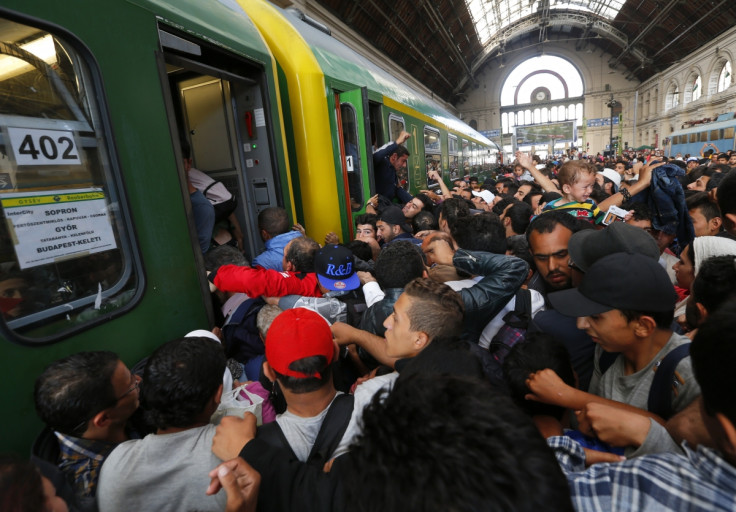EU migrant crisis in numbers: Europe divided over refugee redistribution

Hungarian prime minister Viktor Orban arrived in Brussels for talks on the migrant crisis as chaos returned to Budapest's main railway station, with thousands of migrants flooding the terminal in the hope of boarding a train to northern Europe.
The unprecedented influx of refugees has strained EU relations pitting countries such as Italy and Greece, that would like to see asylum seekers proportionally divided among members, against others, such as Britain, which refuse to take in more people.
Hungary is one of the countries at the forefront of the problem that feels it is being let down by its EU allies. Talks will focus on the so-called Dublin regulation that Germany, France and Italy would like to see overhauled. According to it, refugees currently have to apply for asylum in the first EU country they reach. If they travel to a second EU nation, they can be forcibly sent back to the country of entry.
The system's viability has been brought into question by events such as those unfolding in Budapest, where thousands of migrants go to reach a destination of their choice. It is also accused of putting an unfair burden on countries on the outer borders of the union, such as Italy and Greece, which have long complained about being overwhelmed by asylum seekers reaching their shores.
As governments scramble to agree a common plan, IBTimes UK looks at some figures of the crisis.
A record number of more than 320,000 refugees and migrants have crossed EU borders so far this year, mainly through a dangerous sea route across the Mediterranean to Greece and Italy. Some 107,500 arrived in July alone, while more than 2,600 are believed to have died at sea since January.
Greece has become the main port of entry, as asylum seekers fleeing war and poverty in the Middle East and Africa make a short sea crossing from Turkey to islands scattered in the Aegean Sea, from where they are then taken to reception centres in mainland Europe. Athens records thousands of new entries every day, totalling more than 200,000 so far in 2015.
About another 115,000 have reached Italy, usually crossing on rickety boats operated by smuggler gangs based in Libya. Rome said it is currently accommodating more than 93,000 migrants in reception centres across the country.
Throughout the summer arrivals have been fourfold higher than in 2013, interior ministry figures show, with more than 20,000 disembarking every month. Numbers are however in line with last summer's influx, partially because the route to Greece has become more popular, a ministry official explained. It is infact perceived as less dangerous for it involves a shorter stretch of water and no contact with Libyan gangs and militias running amok in the collapsing African country.
From Greece, tens of thousands have travelled by land to Macedonia and then on to Serbia and Hungary, on the way to other northern EU states.
The Hungarian interior ministry said 154,400 people have illegally crossed their border in the first eight months of 2015, compared to the 42,777 registered last year.
Most have Germany has their final destination. Berlin said it expects up to 800,000 asylum applicants and refugees to arrive this year. Numbers from both Germany and Hungary are swollen also by thousands migrants from the Balkans, mainly Kosovo and Albania, figures from the EU border agency Frontex show.
Arrivals in these countries however remain highly disproportionate if compared to those in other European powerhouses.
Spain, which opposes a quota system to redistribute refugees has received only about 2,100 this year. From January to May 3,800 people filed for asylum with the Madrid government, according to EU data, less than those who applied in the city of Hamburg last month only.
Smaller Austria has recorded 20,645 asylum applications in the same five-month period and said it expects the total to reach 80,000 by the end of the year. Up to June asylum applicants surpassed 32,000 In France, while almost 29,000 filled in forms to find a new home in Sweden.
In the same period the UK received more than 13,000 applications. Figures on arrivals and asylum application can differ greatly because, among other factors, it might take a long time before a refugee files a request and not only those reaching Europe via sea apply for asylum. For example, the UK has received several thousand applications from Syrian refugees but many were already living in Britain, unable to go back home because of the civil war.
The British government recently said it has taken in only 216 refugees, mainly Syrians, under a relocation initiative for vulnerable people launched last year.
With Afghans, Eritreans, Nigerians and Kosovars, Syrians make up the lion's share of people reaching Europe in the hope of a better life.
© Copyright IBTimes 2025. All rights reserved.




















